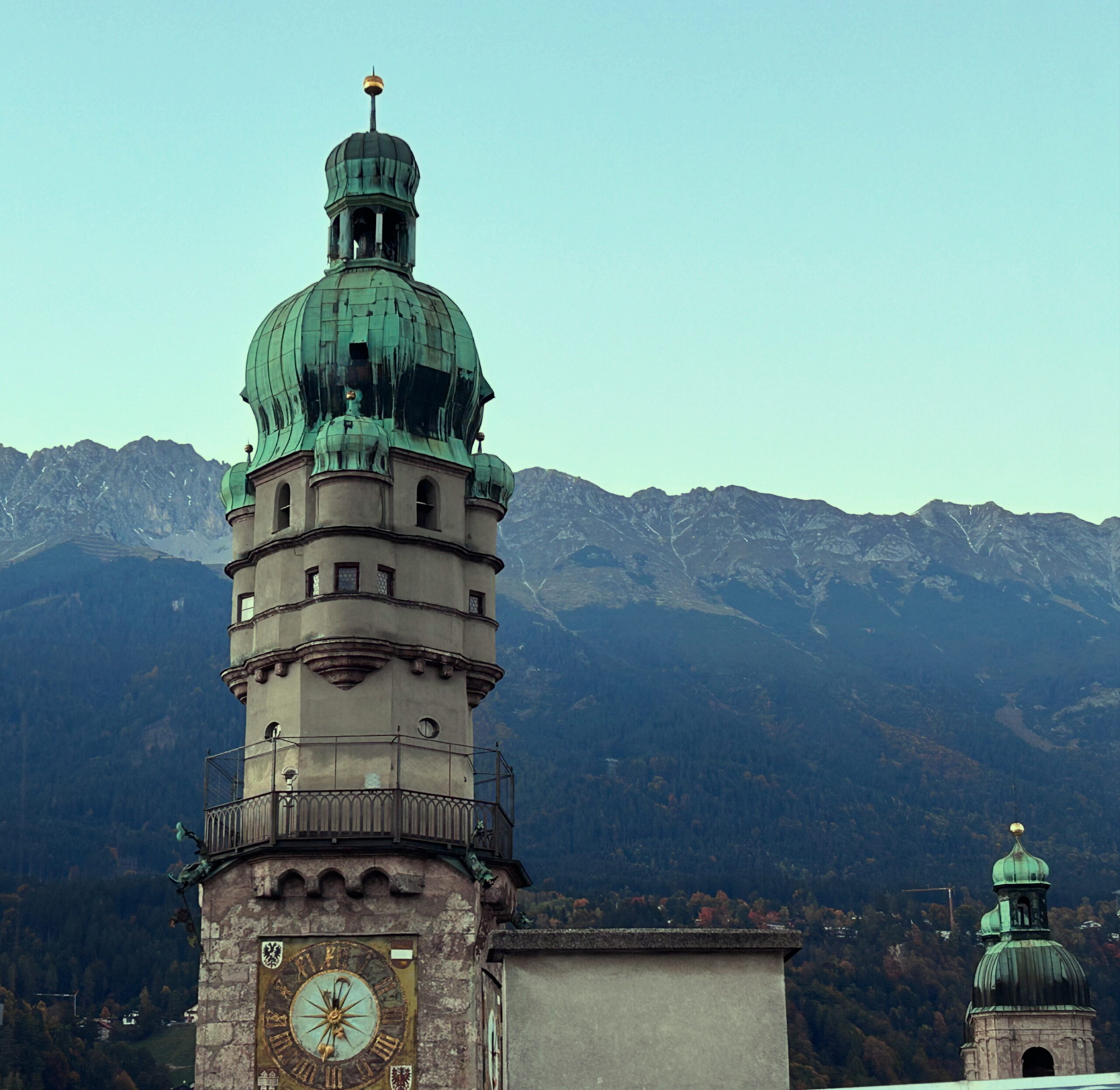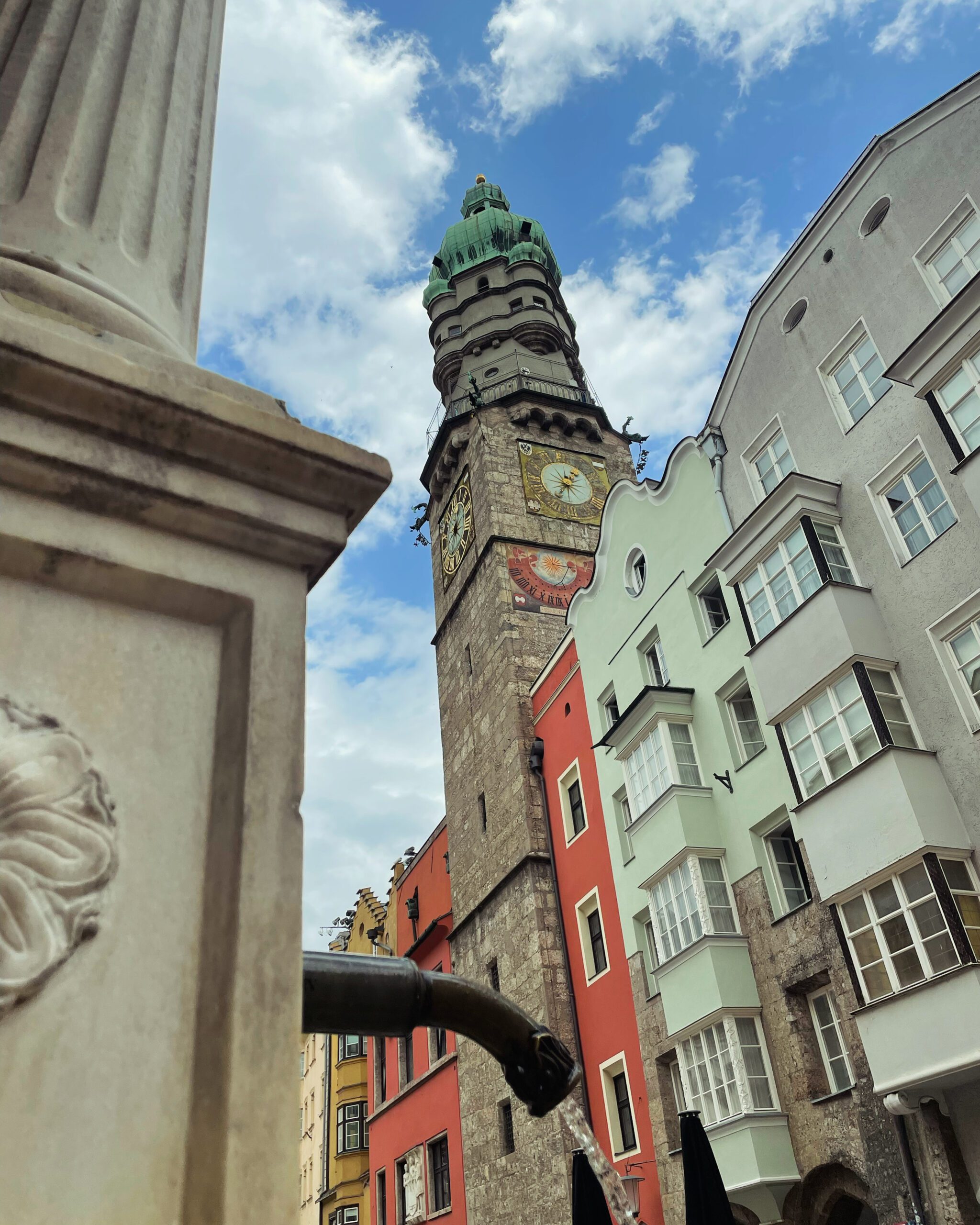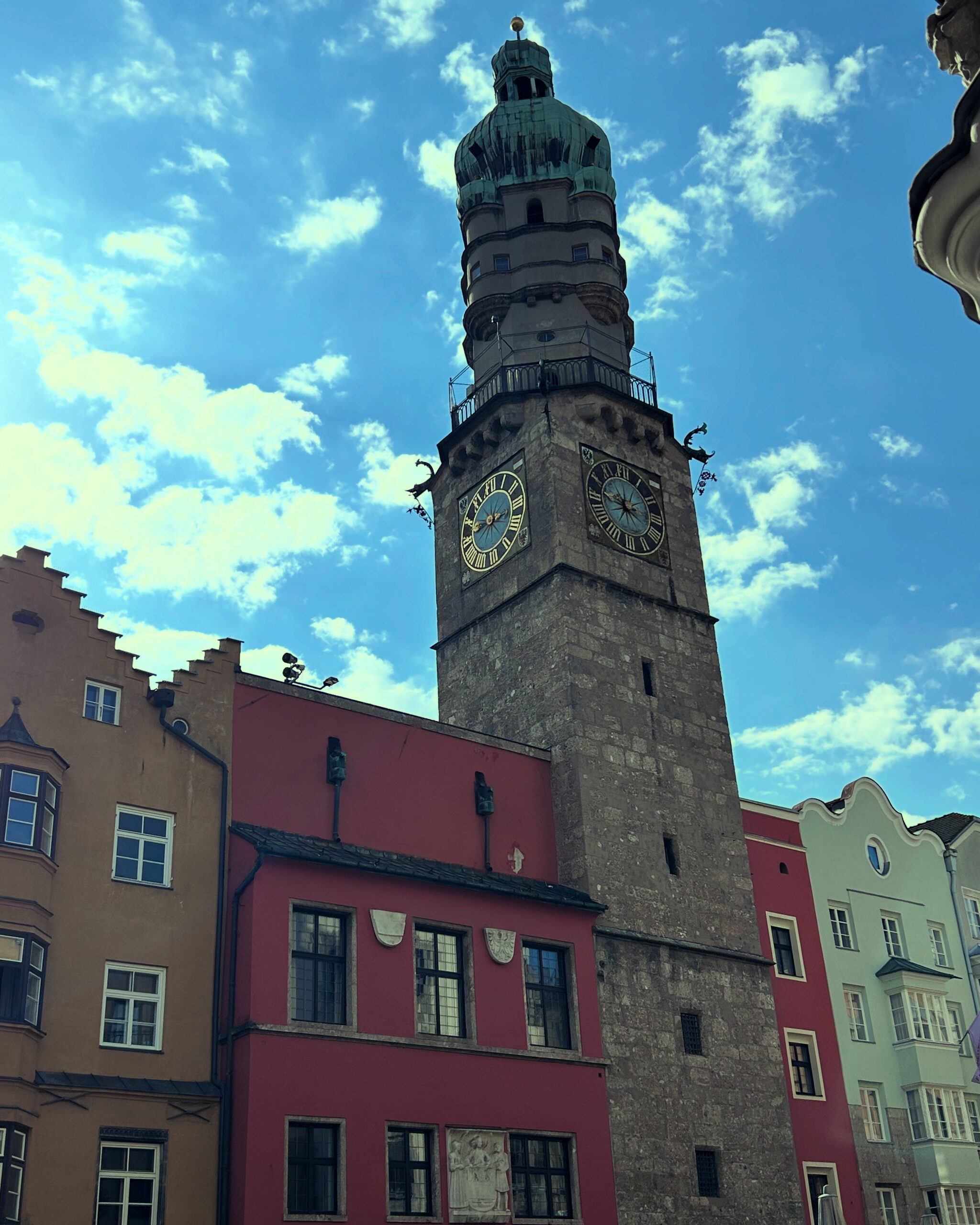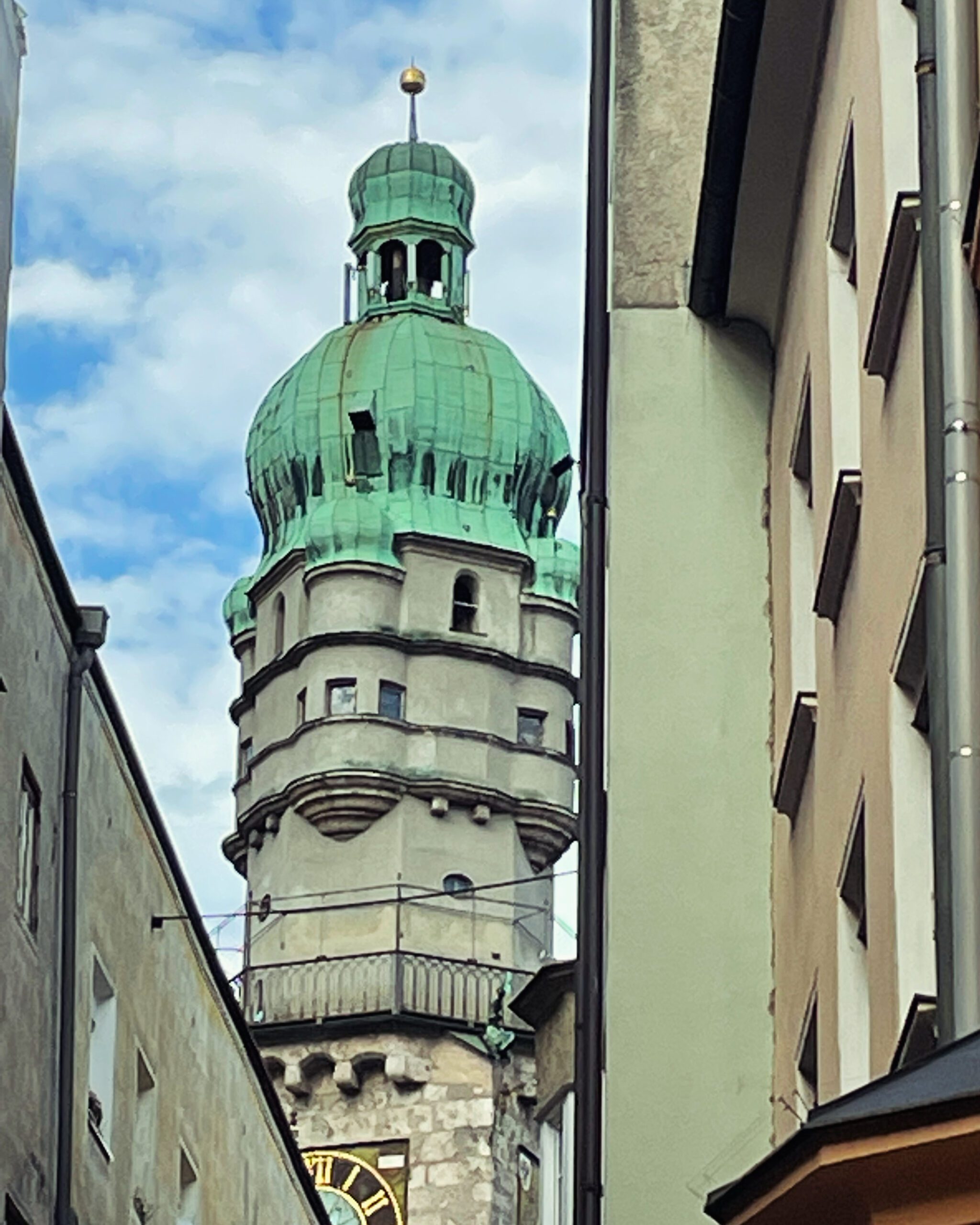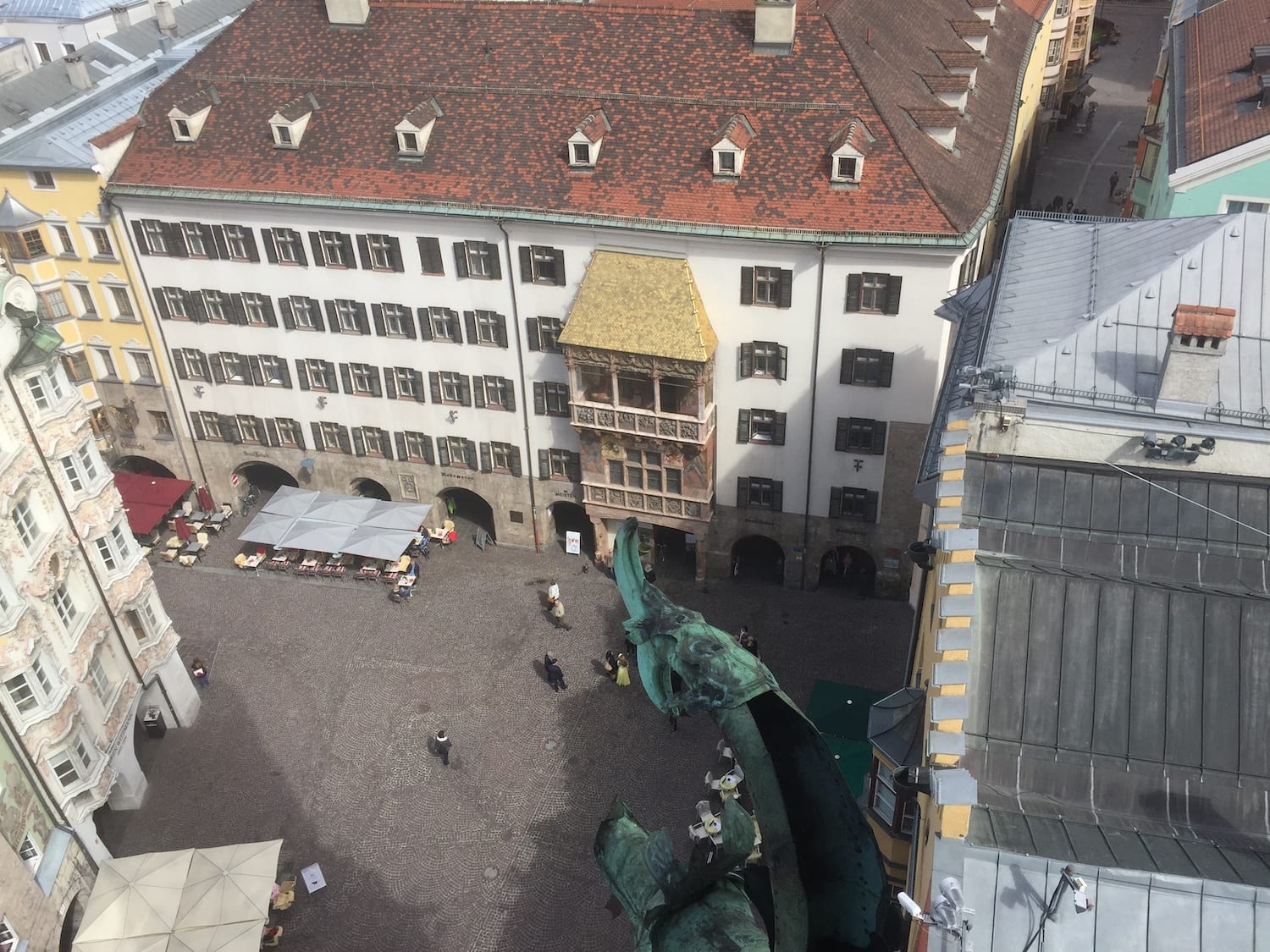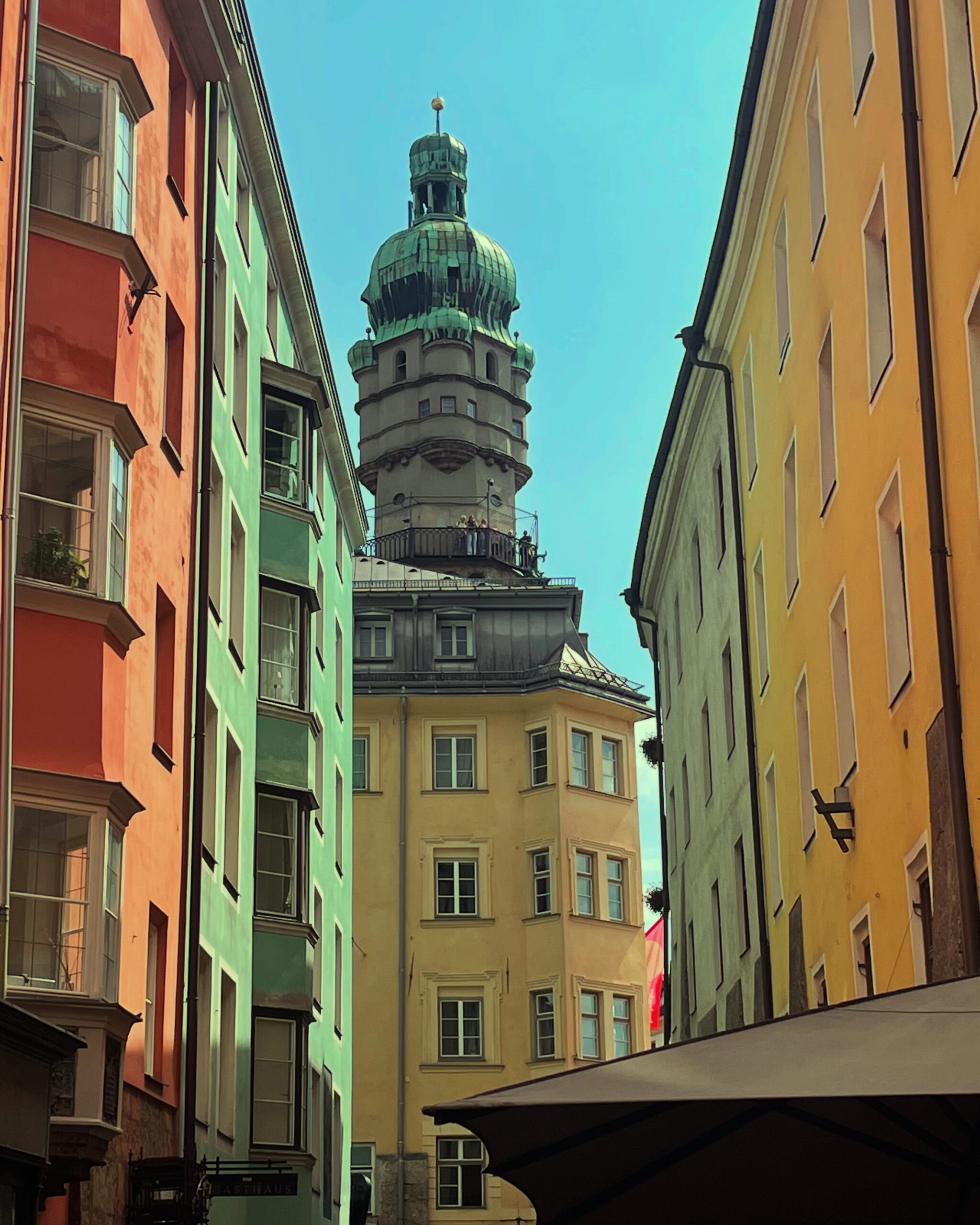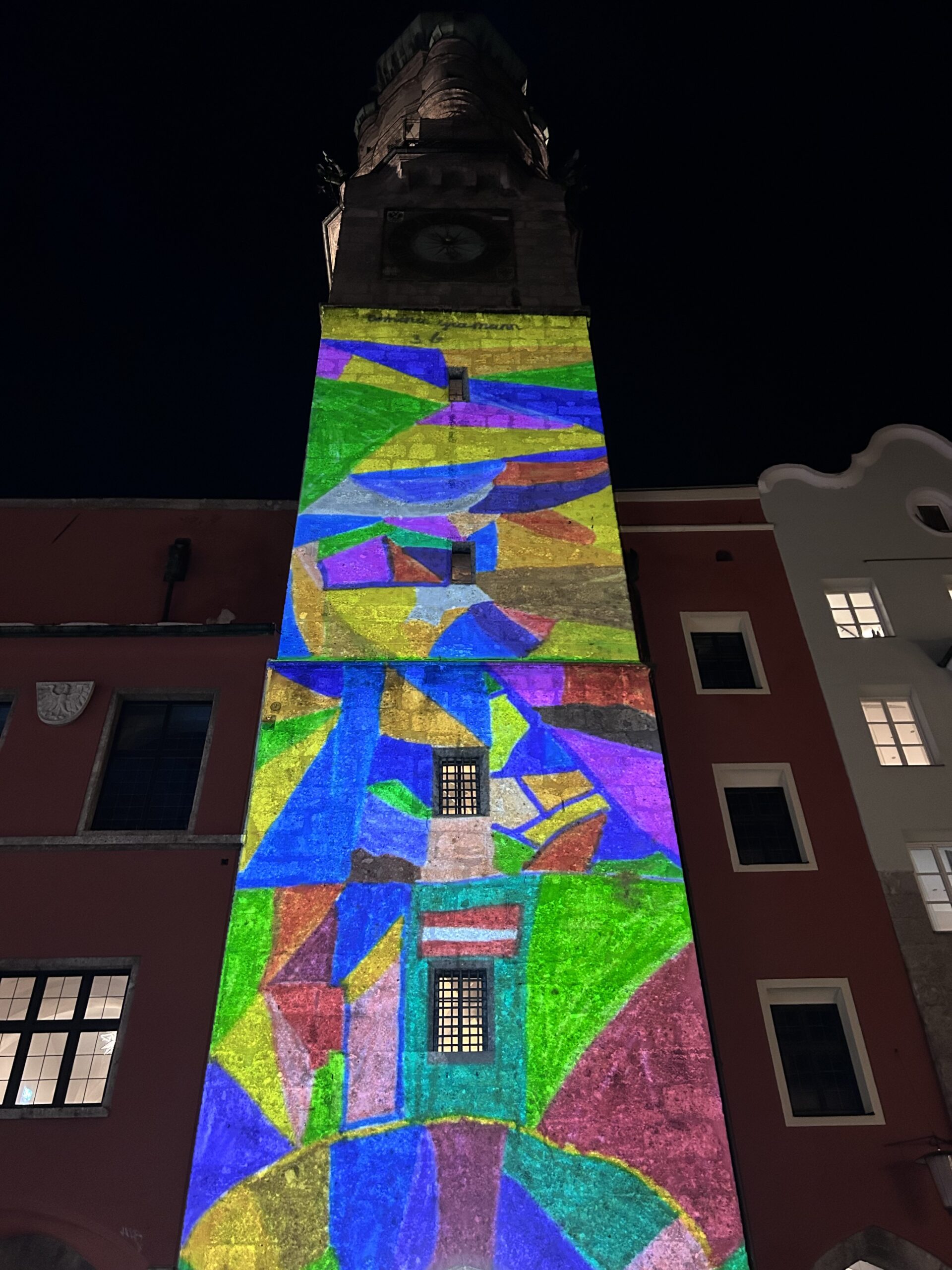City tower & old town hall
Herzog-Friedrich-Straße 21
Worth knowing
The red building flanking the city tower is the Old town hallFor a long time, it was the seat of the town council and the mayor. Until the 14th century, the town's agendas were handled in the house of the town magistrate or mayor. In addition to a lack of transparency, these were not ideal working conditions for managing an ever-growing municipality with its own town council. Prince Ludwig von Brandenburg issued a special tax to enable the financing of the town hall. In 1358, construction was completed on the Upper Town Square. It was the first official town hall in a Tyrolean town. Mayor and Common as official bodies, now also had a suitable home. The modest building was constructed before Innsbruck's heyday and was not intended to display bourgeois splendour, but was an administrative building. The market supervisors also sat in the town hall. They had control over the goods on offer and their quantity and quality. The bread was sold by the "Bred guardian" in the bread bank in the town hall to prevent usury and fraud.
The town hall was remodelled, extended and renovated several times - the earthquake of 1689 did not spare the town hall either - and took on its current form. A relief on the façade commemorates the confirmation of the town charter in 1239. The plaque was added in 1939 to mark the 700th anniversary of this event, based on a design by Hans Andre. Despite the anti-clerical stance of the National Socialists, Andre managed to incorporate an angel as the herald of the town charter. The costumes of the depicted figures are not a depiction of the actual fashion of the Innsbruck bourgeoisie of the 13th century, but provide information about what was seen as the German ideal of the German city of Innsbruck in the early days of National Socialism.
The symbolic sign of civic pride in the town charter was not built until later. The city tower was built between 1442 and 1450 during the reign of Frederick IV. Innsbruck was now a royal seat. The increasingly wealthy citizens of Innsbruck and the sovereign wanted to demonstrate their new-found self-confidence. In 1560, the bulky tower was topped off with an onion-shaped roof, the so-called Augsburg bonnet. This shape was very fashionable, as Augsburg was one of the most important cities in Europe at the time as the home and business centre of the merchant family Jakob Fuggers. Skilfully crafted copper gargoyles in the shape of dolphins cavort beneath the bonnet.
But the city tower was not just an expression of Innsbruck's vanity. There was a prison on the first floor. From the platform above, the tower guard had to keep an eye out for danger, monitor the city and, above all, sound the alarm in the event of a fire. Another task of the tower guard was to announce the time. Unlike today, not every citizen had a watch on their wrist. The special thing about time in the Middle Ages was that it was different in every village. Innsbruck had a different time to Hall or Schwaz. It was only with industrialisation and the railway that a synchronised understanding of time became important. Service and timetables made it necessary to reinvent time.
Despite several design attempts in the second half of the 19th century, the expansion of the Old Town Hall within the historic city centre failed due to a lack of space. The New Town Hall with its offices has been located in Maria-Theresien-Straße since 1897, where the city administration, catering and shopping facilities are combined in a covered gallery to form a kind of modern citizens' forum. The city tower offers the opportunity to view the old town from above. At a height of 55 metres, you can feel like a medieval tower guard and look out over the entire old town. Especially the view of Helblinghaus und Goldenes Dachl and the Nordkette mountain range in the background form the backdrop for this very special photo.
Big City Life in early Innsbruck
Innsbruck had developed from a Roman castle into a town during the Middle Ages. This formal recognition of Innsbruck as a town by the sovereign brought with it a completely new system for the citizens. Market law, building law, customs law and its own jurisdiction were gradually transferred to the city. Customs law in particular was a control tool of the sovereigns. While central banks changed key interest rates, rulers had customs duties and levies at their disposal after natural disasters, epidemics, fires or wars in order to stimulate trade, consumption and the economy.
Townspeople were no longer subject to their landlord, but to municipal jurisdiction, at least within the town walls. The popular saying "Stadtluft macht freiThe term "burgher" came from the fact that after one year in the city, one was free of all obligations to one's former landlord. Unlike unfree peasants and servants, burghers were free to dispose of their property and lifestyle as they wished. Citizens did not pay tithes, but paid taxes to the city. The city government itself could determine which group within the city had to pay which tax. The city in turn did not have to pay these taxes directly, but was free to dispose of its budget after deducting a fixed levy to the sovereign. In addition to defence, expenses included care for the sick and poor. Citizens in need could go to the "Boiling kitchen" food, if they had the right of citizenship. The city government paid particular attention to infectious diseases such as the plague.
In addition to taxes, customs duties were an important source of income for Innsbruck. Customs duties were levied at the city gate at the Inn bridge. There were two types of customs duty. The small duty was based on the number of draught animals in the wagon, the large duty on the type and quantity of goods. The customs revenue was shared between Innsbruck and Hall. Hall had the task of maintaining the Inn bridge.
In return for their rights, every citizen had to take the oath of citizenship. This civic oath included the obligation to pay taxes and perform military service. In addition to defending the town, the citizens were also deployed outside the town. In 1406, a delegation together with mercenaries opposed an Appenzell army in defence of the Upper Inn Valley. From 1511, according to Emperor Maximilian's Landlibell, the town council was also obliged to provide a contingent of conscripts for the defence of the country. In addition to this, there were volunteers who Freifähnlein For example, during the Turkish siege of Vienna in 1529, Innsbruckers were among the city's defenders.
In the 15th century, space became tight in the rapidly growing city of Innsbruck. Citizenship became an exclusive right. Only free subjects born in wedlock were able to obtain city rights. To become a citizen, you had to either own a house or have skills in a trade in which the city's guilds were interested. The dispute over who is a "real" Innsbrucker and who is not continues to this day. The fact that migration and exchange with others have always guaranteed prosperity and made Innsbruck the liveable city it is today is often forgotten.
Due to these restrictions, Innsbruck had a completely different social composition to the neighbouring villages. Craftsmen, merchants, civil servants and servants of the court dominated the cityscape. Merchants were often travelling people, officials and court servants also came to Innsbruck for a short time as part of a prince's entourage and did not have citizenship. It was the craftsmen who exercised a large part of the political power within the citizenry. Unlike peasants, they belonged to the mobile classes in the Middle Ages and early modern period. After their apprenticeship, they went to the Walzbefore they took the master craftsman's examination and either returned home or settled in another city. Craftsmen not only transferred knowledge, they also spread cultural, social and political ideas. The craft guilds sometimes exercised their own jurisdiction alongside the municipal jurisdiction among their members. They were social structures within the city structure that had a great influence on politics. Wages, prices and social life were regulated by the guilds under the supervision of the sovereign. One could speak of an early social partnership, as the guilds also provided social security for their members in the event of illness or occupational disability. Individual trades such as locksmiths, tanners, platers, carpenters, bakers, butchers and blacksmiths each had their own guild, headed by a master craftsman.
From the 14th century, Innsbruck demonstrably had a city council, the so-called Gemainand a mayor who was elected annually by the citizens. These were not secret but public elections, which were held every year around Christmas time. In the Innsbrucker Geschichtsalmanach von 1948 findet man Aufzeichnungen über die Wahl des Jahres 1598.
The Feast of St. Erhard, i.e., January 8th, played a significant role in the lives of the citizens of Innsbruck each year. On this day, they gathered to elect the city officials, namely the mayor, city judge, public orator, and the twelve-member council. A detailed account of the election process between 1598 and 1607 is provided by a protocol preserved in the city archive: "... The ringing of the great bell summoned the council and the citizenry to the town hall, and once the honorable council and the entire community were assembled at the town hall, the honorable council first convened in the council chamber and heard the farewell of the outgoing mayor of the previous year, Augustin Tauscher."
The mayor represented the city vis-à-vis the other estates and the prince, who exercised sovereignty over the city to a greater or lesser extent depending on the era. Each city councillor had their own clearly assigned tasks to fulfil, such as the supervision of market law, the care of the hospital and poor relief or the customs regulations, which were particularly important for Innsbruck. The consumption of alcohol and lingering in public houses was regulated differently at different times. Not only was it too expensive for poorer sections of the population, they were also only allowed to enter the inns at certain times. This was to prevent excessive drunkenness and the begging of the upper classes. The city council controlled the quality and flavour of the food, similar to an early market office, as cities were interested in the quality of their businesses in order to be attractive as a business location and for guests.
In all these political processes, one should always remember that Innsbruck had around 5,000 inhabitants in the 16th century, only a small proportion of whom were citizens. The dispossessed, travellers, unemployed, servants, diplomats, employees, women and students were not eligible to vote. Voting was a privilege of the male upper class.
Contrary to popular belief, the Middle Ages were not a lawless time of arbitrariness. At both local and national level, there were codes that regulated very precisely what was permitted and what was forbidden. This could vary greatly depending on the ruler and the prevailing morals and customs. Carrying weapons, swearing, prostitution, making noise, playing music, blasphemy, children playing - anything and anyone could be targeted by the guardians of the law. If you include the rules for trade, customs duties, the exercise of professions by guilds and price fixing for all kinds of goods by the magistrate, pre-modern and early modern coexistence was no less regulated than it is today. The difference was control and enforcement power, which the authorities often lacked.
If someone was caught committing an unlawful or immoral act, there were courts that passed judgement. The medieval court days were held at the "Dingstätte" is held outdoors. The tradition of the Thing goes back to the old Germanic Thingwhere all free men gathered to dispense justice. The city council appointed a judge who was responsible for all offences that were not subject to the blood court. He was assisted by a panel of several jurors. Punishments ranged from fines to pillorying and imprisonment. The city also monitored compliance with religious order. "Heretics" and dissenters were not reprimanded by the church, but by the city government.
The penal system also included less humane methods than are common today, but torture was not used indiscriminately and arbitrarily. However, torture was also regulated as part of the procedure in particularly serious cases. Until the 17th century, suspects and criminals in Innsbruck were Kräuterturm at the south-east corner of the city wall, on what is now Herzog-Otto-Ufer. Both the trial and the serving of the sentence were public trials. The city tower was Fool's cottagea cage in which people were locked up and put on display. On the wooden Schandesel you were dragged through the town for minor offences. The pillory was located in the suburb, today's Maria-Theresien-Straße. There was no police force, but the town magistrate employed servants and town watchmen were posted at the town gates to keep the peace. It was a civic duty to help catch criminals. Vigilante justice was forbidden.
The responsibilities between municipal and manorial justice had been regulated in the Urbarbuch since 1288. The provincial court still had jurisdiction over serious offences. Crimes such as theft, murder and arson were subject to this blood law. The provincial court for all municipalities south of the Inn between Ampass and Götzens was located on the Sonnenburgwhich was located to the south above Innsbruck. In the 14th century, the Sonnenburg district court moved to the upper town square in front of the Innsbruck city tower, later to the town hall and in the early modern period to Götzens. With the centralisation of the law in the 18th century, the court moved to Götzens. Sonnenburg back to Innsbruck and was housed under different names and in different buildings such as the Leuthaus in Wilten, on the Innrain or at the Ettnau residence, known as the Malfatti Castlein the Höttinger Gasse.
From the late 15th century, Innsbruck's executioner was centralised and responsible for several courts and was based in Hall. The execution centres were located in several places over the years. For a long time, there was a gallows on a hill in today's Dreiheiligen district, right next to the main road. The Köpflplatz was located until 1731 at today's corner of Fallbachgasse / Weiherburggasse in Anpruggen. In Hötting, the gallows stood behind the Chapel of the Great God. Here, the condemned could send a final prayer to heaven before the rope was hung around his neck or his head was cut off, depending on his status in society and the crime he had committed. It was not uncommon for the condemned man to slip his executioner a kind of tip so that he would endeavour to aim as accurately as possible in order to make the execution as painless as possible. A lot could go wrong. If the sword was not aimed accurately, if the noose was not carefully placed or if the rope even broke, the suffering of the condemned man was increased. Delinquents who were particularly harmful to the authorities and public order, such as the „heretic“ Jakob Hutter or the captured leaders of the peasant uprisings of 1525 and 1526, were executed before the sword. Goldenen Dachl executed in a manner suitable for the public. "Embarrassing" punishments such as quartering or wheeling, from the Latin word poena were not the order of the day, but could be ordered in special cases. Executions were a demonstration of power by the authorities and were public. It was seen as a way of cleansing society of criminals and was intended to serve as a deterrent. Large crowds gathered to accompany the gallows bird on its final journey. Classes at the university were suspended on execution days to allow students to attend and purify them. The bodies of the executed were often left hanging and buried outside the consecrated area of the cemeteries or given to the university for study purposes. The last public execution in Austrian history took place in 1868. Even then, people were not squeamish, but the killings on the stranglehold, which was the method of choice for executions until the 1950s, were no longer a spectacle in front of an audience.
With the centralisation of law under Maria Theresa and Joseph II in the 18th century and the General Civil Code in the 19th century under Franz I, the law passed from cities and sovereigns to the monarch and their administrative bodies at various levels. Torture was abolished. The Enlightenment had fundamentally changed the concept of law, punishment and rehabilitation. The collection of taxes was also centralised, which resulted in a great loss of importance for the local nobility and an increase in the status of the civil service. With the increasing centralisation under Maria Theresa and Joseph II, taxes and customs duties were also gradually centralised and collected by the Imperial Court Chamber. As a result, Innsbruck, like many municipalities at the time, lost a large amount of revenue, which was only partially offset by equalisation.
Innsbruck - city of bureaucrats and civil servants
Innsbruck is proud of its many titles. University city, Austria's capital of sport or home to the world's best hospital. If you take a look at the list of the region's largest employers or at its history, Innsbruck is one thing above all: a city of civil servants. The university and provincial hospital are the largest single employers. However, if you add up the public servants at all levels, city, state and federal, and include the outsourced companies owned by the public sector such as ÖBB, TIWAG or Innsbrucker Kommunalbetriebe as well as teachers and the police, the civil servants are clearly in the majority. At the latest since the relocation of the royal residence under Frederick IV, civil servants have not only made up a considerable proportion of the city's population in quantitative terms, they have also determined the fate of the city in an influential, albeit inconspicuous manner. To this day, it is civil servants who keep things running smoothly. They enforce laws, take care of the planning and maintenance of infrastructure, eagerly keep records of the population in order to collect taxes and draft soldiers.
Die erste nennenswerte Bürokratie kam wohl mit dem Roman Empire. Den Römern folgten im frühen Mittelalter die Brüder des Stiftes Wilten. Die schreibkundigen Männer verwalteten nicht nur die herzoglichen und eigenen Besitztümer durch ihre Urbare und hoben die Abgaben bei den bäuerlichen Untertanen ein, sondern legten Taufmatrikel, Heiratsverzeichnisse und Sterbebücher an. Die Feudalherrschaft erforderte zwar einen Panoramablick über das, was sich innerhalb ihres Herrschaftsbereichs abspielte, vor allem in der Stadt war das Leben aber eher von den Beschränkungen der Zünfte als von denen der Obrigkeit bestimmt. Ein Magistrat war nur oberflächlich vorhanden. Es gab Gesetze, aber keine Polizei, Steuern aber kein Finanzamt. Städtische Infrastruktur war praktisch nicht vorhanden, schließlich gab es weder fließend Wasser, elektrischen Strom, Kanalisation, städtische Kindergarten, ein Arbeitsamt oder eine Krankenkasse. Die zur Stadt erhobene Gemeinde Innsbruck wurde lange von einem Stadtrichter, ab dem 14. Jahrhundert von einem Bürgermeister mit Gemeinderat regiert. Es handelte sich dabei nicht um hauptberufliche Beamte, sondern Mitglieder der städtischen Elite. Nur wenige Menschen wie Zöllner, Kornmesser, Schreiber oder Turmwächter standem bei der Stadt unter Lohn und Brot.
Im 15. Jahrhundert wurden Berufswelt und Gesellschaft differenzierter, die Heere größer und die Steuerbelastungen höher. Das traditionelle Gewohnheitsrecht wurde vom modernen, für Unkundige schwerer durchschaubaren Römischen Recht abgelöst. Mit der Stadt wuchs auch der Beamtenapparat. Zwischen Anfang des 15. Jahrhunderts und der Regierung Leopolds V. war Innsbruck von einer Handels- und Transportsiedlung zu einer Beamtenstadt geworden. Von den circa 5500 Einwohnern gehörte mehr als die Hälfte dem Hofstaat, der städtischen Beamtenschaft, der Universität oder dem Klerus an. Hofhaltung, Verwaltung, Zoll, Steuern, Fernhandel und Finanzwirtschaft benötigten schreibkundiges Personal. Die Verwaltung war, vor Handwerk, Transport und Gastronomie zum wichtigsten Wirtschaftszweig der Stadt geworden.
Wenn überhaupt kamen die Bürger mit diesen fremden Beamten nur in unangenehmen Situationen in Berührung. Besonders straff wurden die Zügel von Maximilian I. angezogen. Seine zentral beschlossenen Gesetze wurden von den Reichskreisen lokal umgesetzt. Die besoldeten Beamten durchdrangen das Leben des Einzelnen in einer Art und Weise, die es im Mittelalter so nicht gab. Zu allem Übel kamen die Beamten oft aus dem Ausland. Besonders Italiener und Burgunder waren gefragte Schlüsselarbeitskräfte, die aber mit der einheimischen Bevölkerung fremdelten. Nicht nur sprachen sie oft kein Deutsch, sie konnten lesen und schreiben, waren Angestellte und keine untertänigen Landwirten. Sie hatten mehr Geld zur Verfügung, kleideten sich anders, hatten andere Sitten und aßen andere Speisen. Anders als der Landesfürst beriefen sie sich nicht auf Gott, sondern auf von Menschen geschriebene, von der Antike und der Vernunft inspirierte Regelwerke. Je nach Mode, Sitte und Moralvorstellung der Zeit, änderten sich die Gesetze. So wie Naturschutz oder Tempolimits auf Autobahnen heute immer wieder zur Diskussion gestellt werden, obwohl sie Sinn machen, wurden damals Verbote von Ausspucken, Entsorgung des Nachttopfes, Holzbauten und Viehhaltung innerhalb der Stadtmauern kritisch gesehen, obwohl sie Hygiene und Sicherheit drastisch erhöhten.
While it had long been customary for citizens to take certain liberties with logging, building, hunting and fishing in the absence of the ruler, the bureaucracy was always present. While the sovereign was seen as a good father to his subjects and bishops and abbots were strict landlords, but could at least offer salvation in return, the new authorities appeared anonymous, aloof, faceless, foreign and distant. The basis for negotiation that you had as a subject in direct contact with your landlord was buried by the merciless law, at least if you could not pay bribes or did not know anyone in a higher position. When unconditional faith in the increasingly corrupt clergy began to crumble and Ferdinand I appointed the Spaniard Salamanca as the country's chief financial administrator, the underlying dissatisfaction turned into open rebellion in 1525. The subjects did not demand the removal of the prince, but a change in the rule of the clergy and foreign officials. Even in the 17th century, it was the country's highest civil servant, Wilhelm Biener, whose head rolled and not that of the sovereign.
Bureaucracy, the rule of the administration, also had advantages for the subjects. It established fixed rules where arbitrariness often prevailed. The law, harmonised across different territories, was more predictable. And with a bit of luck and talent, it was possible to climb the social ladder by serving the public authorities, even without belonging to the nobility. Michael Gaismair, one of the leaders of the 1525 rebellion, was the son of a mining entrepreneur and had been in the service of the provincial governor before his career as a revolutionary.
The next modernisation of the administration took place in the 18th century. Under the enlightened, absolutist monarchs Maria Theresa and Joseph II, a new wind blew right down to the municipal level. Innsbruck was given a police force for the first time. The city administration was modernised in 1784. Instead of the old city council with Common regierte nun ein von einem Rat, vor allem aber von Beamten unterstützter, offiziell in Sold und Brot des Staates stehender Bürgermeister. Fünf angestellte Magistratsräte und sechs unbesoldete Magistratsräte, und über 30 Beamte bildeten das Stadtmagistrat. Er bestand damit nicht mehr aus Laien, sondern zu einem großen Teil aus Experten, die zwar immer noch vorwiegend aus Mitgliedern des Kleinadels bestanden, sich nun aber durch Prüfungen für die Ausübung ihres Amtes qualifizieren mussten. Die Bürokratie erhielt auf operativer politischer Ebene mehr Macht. Während der Bürgermeisterposten zeitlich begrenzt war, kamen Beamte in den Genuss einer lebenslangen, unkündbaren Stellung. Diese Pragmatisierung und ein neuerlicher Schwall an neuen, oftmals den Traditionen widersprechenden Gesetzen, verstärkten den Ruf der Beamten, abgehoben und bürgerfern zu sein. Als mit der bayerischen Besetzung Tirols das Element des ausländischen, noch dazu nach französischem Vorbild, dazukam, brach 1809 erneut ein Aufstand aus. Die Massenaushebung junger Männer für den Militärdienst, eine Reglementierung des religiösen Lebens und eine Impfpflicht, durchgesetzt von bayerischen Beamten, war zu viel für die Tiroler Seelenlandschaft.
After 1809, bureaucracy found its way into more and more areas of life in the context of industrialisation and new technologies. Not only the state system through taxes and the military, but also the university, schools, construction, railway, post office and institutions such as the Chamber of Commerce and Industry required administrative staff. The city grew in terms of inhabitants and businesses. New infrastructure such as gas, sewerage and electricity and new ideas about hygiene, food control, health and education called for new employees in the city magistrate's office. The old town hall in the historic city centre became too small. A planned extension proved to be impossible. In 1897, the officials moved to the new town hall in Maria-Theresien-Straße. The move was made possible by a generous donation from the industrialist and hotelier Leonhard Lang. In 1905, the Tyrolean provincial government and its various offices found a new home for a short time in Palais Fugger-Taxis before moving to the Gauhaus on Landhausplatz.
Als 1918 die Monarchie zusammenbrach, war der Übergang nicht nahtlos, dank der Strukturen verlief er aber unvorstellbar glatt. Es war aber nicht mehr der Kaiser, der die Last des Staates trug, sondern eine Heerschar an Staatsbediensteten und Hütern der Ordnung, die für Wasser, Strom und ein funktionierendes Eisenbahnnetz sorgten. Mit Eduard Klingler und Theodor Prachensky hinterließen zwei Bauamtsleiter in der ersten Hälfte des 20. Jahrhunderts ihre bis heute gut sichtbaren Spuren im Innsbrucker Stadtbild. Die Republik übernahm mit Agenden wie dem öffentlichen Wohnbau, dem Arbeitsamt, dem Bildungswesen, der städtischen Infrastruktur, Straßenbau, öffentlichem Verkehr bis hin zu Meldewesen und Hochzeit mehr oder minder alle Aufgaben des täglichen Lebens von Monarchie und Kirche. Wer sich also beim nächsten Besuch im Neuen Rathaus über überbordendes Beamtentum und quälend langsame Bürokratie ärgert, dem sei in Erinnerung gerufen, dass der Wohlfahrtsstaat in Person seiner Staatsdiener von der Wiege bis zur Bahre das soziale Auskommen und öffentliche Infrastruktur Tausender Menschen meist unbemerkt managed.
Friedl with the empty pocket
The Tyrolean Prince Frederick IV (1382 - 1439) lived during a turbulent period in Habsburg and Innsbruck history. Although the Habsburgs had been in the high nobility for some time, their power had not yet been consolidated. Frederick's face was covered with a long beard. In many chronicles and reports, he was described as arbitrary, power-hungry, deceitful and devious. Contemporaries regarded him as Sexaholicwho, when in doubt, did not shy away from violence to enforce his will. This was not unusual, however, if you look at the biographies of other princes of the late Middle Ages. Whether he was a miserly moral scoundrel or a skilful politician and friend of the common man - the key dates of his life would be suitable material for an adventurous medieval film.
At the age of 24, Frederick took over the county of Tyrol as well as the regency of Vorderösterreich. Vorderösterreich? So Vorarlberg? Not quite. Vorderösterreich was understood to mean the Habsburg possessions in Switzerland, Vorarlberg, Alsace and Baden-Württemberg, among others. Tyrol and Vorderösterreich had been administered jointly since Frederick as Upper Austria. This made him one of the most powerful princes of the Heiligen Römischen Reiches. From the beginning of his reign, he was involved in costly wars against hostile powers on the country's borders and competition within the Heiligen Römischen Reiches involved. In the west, the Appenzellers rose up against the Habsburgs, in the south there was an uprising in Trento and Henry of Rottenburg instigated a feud north of the Inn. These were the last conflicts to be fought in the manner of pure knightly armies.
Like his predecessor Margarethe in the princely chair, Frederick also came into conflict with the Pope. In his time, there was a pope in Avignon, France, as well as a pope in Rome. This papal issue was to be resolved at the Council of Constance, perhaps the most important political event of the late Middle Ages in Europe. Frederick sided with John XXIII. The King of the Holy Roman Empire Sigismund from the Luxembourg dynasty, who backed the antipope in Avignon, had his rival within the empire, Frederick, rewarded with the Eight and imprisoned. This meant not only deprivation of liberty and expulsion from the church, but also the loss of his territories and property. His opponents gave him the nickname Friedl mit der leeren Tasche. Once back in Innsbruck after an adventurous escape from prison, Frederick had to grant reforms to the population, especially the landowning lesser nobility and the towns, in recognition of their support in times of great need. In addition to the clergy, the nobility and the towns, the courts, which were responsible for the administration of the rural communities, were also allowed to send their representatives to the Diet.
Frederick's nickname remained in the vernacular, even though at the end of his reign he was one of the richest princes in Europe of his time thanks to the rich mining wealth in Schwaz and Gossensass as well as customs duties and tolls on trade between Venice and Augsburg. The largest silver mine in Europe and the mining industry also had a lasting effect on the social structure of Innsbruck. The power of the guilds increased. Although Innsbruck was dependent on the surrounding area for food supplies, the growing prosperity of the city made it easier to manoeuvre through this time of crisis than in purely rural areas. When Frederick died, Tyrol had risen to become an important province within the Habsburg Empire thanks to the silver discoveries in Schwaz.
His residence also changed. Although Innsbruck had already grown, it was still a small town. Frederick decided to make the city on the Inn his residence. In 1420, he bought two town houses within the city walls. Merano had been the ancestral seat of the Counts of Tyrol and remained the official Tyrolean capital until 1849. In fact, Innsbruck had been in the lead at least since Frederick's move. It was during his reign that the arcades in Herzog-Friedrich-Straße were laid out and the city tower was built. Throughout Europe, the 15th century was an economically difficult time, characterised by poor harvests due to the generally worse climate than in previous periods. However, thanks to trade and the impetus provided by the relocation of the court, Innsbruck flourished against the European trend. Schwaz, Meran and Innsbruck were the centres of Tyrol. Schwaz, like Detroit in the 20th century, was a booming working-class town thanks to the silver mines, the venerable old town of Merano as the capital resembled Washington and the residential and trading city of Innsbruck became the New York of Tyrol, the centre of power at the time.
Along with the court, which comprised around 400 people, came officials, servants, merchants, financiers and soldiers who brought money into the city. Above all, the craft guilds were to become the economic engine and the basis for the later early industrial production. It is difficult to say what specific effect the relocation of the residence had on Innsbruck's population. However, Frederick's court brought with it a new lifestyle with its new way of doing business. Public houses opened and offered variety in everyday life. Travelling theatres and show artists came to the city. As in many European cities in German-speaking countries, urbanisation spilled over from the Italian countries and brought a specialisation of the professional world and an even greater division of labour.
Immigration and the rapid change in the social fabric also caused problems. The xenophobia of the superstitious, often illiterate and poorly educated population did not diminish at the same pace as conditions changed. Tensions between long-established and new citizens, craftsmen, merchants, farmers and members of the court were part of everyday life in Frederick's Innsbruck.
Due to his many disputes with other princes and the Pope, his wealth from customs duties and the Schwaz mines and his probably eccentric character, Frederick IV was regarded by his contemporaries as a kind of robber baron. It was only later that he received a more favourable press due to the many legends that have grown up around his person since then. He is said to have travelled the country disguised as a beggar in order to find out what the people really thought of him. From the reports commissioned by the Habsburgs from the 16th century onwards, he comes off much better. His affectionate nickname Friedl mit der leeren Tasche carries this image of the good-natured, awkward prince of Tyrol right up to the present day.
